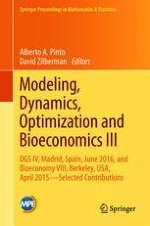The research and review papers presented in this volume provide an overview of the main issues, findings, and open questions in cutting-edge research on the fields of modeling, optimization and dynamics and their applications to biology, economics, energy, finance, industry, physics and psychology.
Given the scientific relevance of the innovative applications and emerging issues they address, the contributions to this volume, written by some of the world’s leading experts in mathematics, economics and other applied sciences, will be seminal to future research developments and will spark future works and collaborations.
The majority of the papers presented in this volume were written by participants of the 4th International Conference on Dynamics, Games and Science: Decision Models in a Complex Economy (DGS IV), held at the National Distance Education University (UNED) in Madrid, Spain in June 2016 and of the 8th Berkeley Bioeconomy Conference: The Future of Biofuels, held at the UC Berkeley Alumni House in April 2015.
